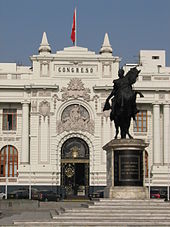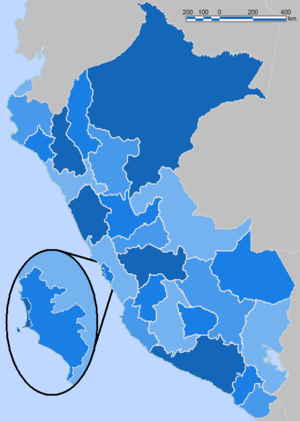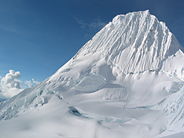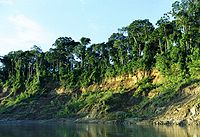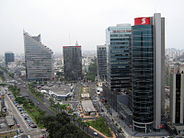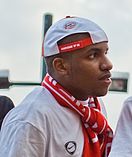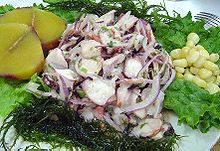- Peru
-
This article is about the country. For other uses, see Peru (disambiguation).
Republic of Peru República del Perú (Spanish)

Flag Coat of arms Anthem: "Himno Nacional del Perú" (Spanish)
"National Anthem of Peru"Capital
(and largest city)Lima
12°2.6′S 77°1.7′W / 12.0433°S 77.0283°WOfficial language(s) Spanish Demonym Peruvian Government Unitary presidential republic - President Ollanta Humala - Prime Minister Salomon Lerner Ghitis Independence from Spain - Declared July 28, 1821 - Consolidated December 9, 1824 - Recognized August 14, 1879 Area - Total 1,285,216 km2 (20th)
496,225 sq mi- Water (%) 0.41 Population - 2010 estimate 29,496,000 (40th) - 2007 census 28,220,764 - Density 23/km2 (191st)
57/sq miGDP (PPP) 2011 estimate - Total $299.648 billion[1] - Per capita $9,985[1] GDP (nominal) 2011 estimate - Total $167.846 billion[1] - Per capita $5,593[1] Gini (2009) ▼48[2] (high) HDI (2010)  0.723[3] (high) (63rd)
0.723[3] (high) (63rd)Currency Nuevo Sol ( PEN)Time zone PET (UTC-5) - Summer (DST) not observed (UTC) Drives on the right ISO 3166 code PE Internet TLD .pe Calling code +51 1 Quechua, Aymara and other indigenous languages are co-official in the areas where they are predominant. Peru
 i/pəˈruː/ (Spanish: Perú; Quechua: Perú;[4] Aymara: Piruw), officially the Republic of Peru (Spanish: República del Perú, pronounced: [reˈpuβlika ðel peˈɾu] (
i/pəˈruː/ (Spanish: Perú; Quechua: Perú;[4] Aymara: Piruw), officially the Republic of Peru (Spanish: República del Perú, pronounced: [reˈpuβlika ðel peˈɾu] ( listen)), is a country in western South America. It is bordered on the north by Ecuador and Colombia, on the east by Brazil, on the southeast by Bolivia, on the south by Chile, and on the west by the Pacific Ocean.
listen)), is a country in western South America. It is bordered on the north by Ecuador and Colombia, on the east by Brazil, on the southeast by Bolivia, on the south by Chile, and on the west by the Pacific Ocean.Peruvian territory was home to the Norte Chico civilization, one of the oldest in the world, and to the Inca Empire, the largest state in Pre-Columbian America. The Spanish Empire conquered the region in the 16th century and established a Viceroyalty, which included most of its South American colonies. After achieving independence in 1821, Peru has undergone periods of political unrest and fiscal crisis as well as periods of stability and economic upswing.
Peru is a representative democratic republic divided into 25 regions. Its geography varies from the arid plains of the Pacific coast to the peaks of the Andes Mountains and the tropical forests of the Amazon Basin. It is a developing country with a high Human Development Index score and a poverty level around 31%. Its main economic activities include agriculture, fishing, mining, and manufacturing of products such as textiles.
The Peruvian population, estimated at 29.5 million, is multiethnic, including Amerindians, Europeans, Africans, and Asians. The main spoken language is Spanish, although a significant number of Peruvians speak Quechua or other native languages. This mixture of cultural traditions has resulted in a wide diversity of expressions in fields such as art, cuisine, literature, and music.
Contents
Etymology
The word Peru is derived from Birú, the name of a local ruler who lived near the Bay of San Miguel, Panama, in the early 16th century.[5] When his possessions were visited by Spanish explorers in 1522, they were the southernmost part of the New World yet known to Europeans.[6] Thus, when Francisco Pizarro explored the regions farther south, they came to be designated Birú or Peru.[7] The Spanish Crown gave the name legal status with the 1529 Capitulación de Toledo, which designated the newly encountered Inca Empire as the province of Peru.[8] Under Spanish rule, the country adopted the denomination Viceroyalty of Peru, which became Republic of Peru after the Peruvian War of Independence.
History
Main article: History of PeruThe earliest evidences of human presence in Peruvian territory have been dated to approximately 9,000 years BCE.[9] The oldest known complex society in Peru, the Norte Chico civilization, flourished along the coast of the Pacific Ocean between 3,000 and 1,800 BCE.[10] These early developments were followed by archaeological cultures such as Cupisnique, Chavin, Paracas, Mochica, Nazca, Wari, and Chimú. In the 15th century, the Incas emerged as a powerful state which, in the span of a century, formed the largest empire in pre-Columbian America.[11] Andean societies were based on agriculture, using techniques such as irrigation and terracing; camelid husbandry and fishing were also important. Organization relied on reciprocity and redistribution because these societies had no notion of market or money.[12]
In 1532, a group of conquistadors led by Francisco Pizarro defeated and captured Inca Emperor Atahualpa. Ten years later, the Spanish Crown established the Viceroyalty of Peru, which included most of its South American colonies.[13] Viceroy Francisco de Toledo reorganized the country in the 1570s with silver mining as its main economic activity and Amerindian forced labor as its primary workforce.[14] Peruvian bullion provided revenue for the Spanish Crown and fueled a complex trade network that extended as far as Europe and the Philippines.[15] However, by the 18th century, declining silver production and economic diversification greatly diminished royal income.[16] In response, the Crown enacted the Bourbon Reforms, a series of edicts that increased taxes and partitioned the Viceroyalty of Peru.[17] The new laws provoked Túpac Amaru II's rebellion and other revolts, all of which were defeated.[18]
In the early 19th century, while most of South America was swept by wars of independence, Peru remained a royalist stronghold. As the elite hesitated between emancipation and loyalty to the Spanish Monarchy, independence was achieved only after the military campaigns of José de San Martín and Simón Bolívar.[19] During the early years of the Republic, endemic struggles for power between military leaders caused political instability.[20] National identity was forged during this period, as Bolivarian projects for a Latin American Confederation floundered and a union with Bolivia proved ephemeral.[21] Between the 1840s and 1860s, Peru enjoyed a period of stability under the presidency of Ramón Castilla through increased state revenues from guano exports.[22] However, by the 1870s, these resources had been squandered, the country was heavily indebted, and political in-fighting was again on the rise.[23]
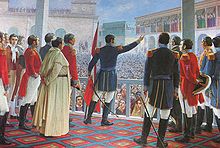 Independence was proclaimed by José de San Martín in 1821.
Independence was proclaimed by José de San Martín in 1821.
Peru was defeated by Chile in the 1879–1883 War of the Pacific, losing the provinces of Arica and Tarapacá in the treaties of Ancón and Lima. Internal struggles after the war were followed by a period of stability under the Civilista Party, which lasted until the onset of the authoritarian regime of Augusto B. Leguía.[24] The Great Depression caused the downfall of Leguía, renewed political turmoil, and the emergence of the American Popular Revolutionary Alliance (APRA).[25] The rivalry between this organization and a coalition of the elite and the military defined Peruvian politics for the following three decades.[26]
In 1968, the Armed Forces, led by General Juan Velasco Alvarado, staged a coup against president Fernando Belaunde. The new regime undertook radical reforms aimed at fostering development but failed to gain widespread support.[27] In 1975, General Francisco Morales Bermúdez forcefully replaced Velasco, paralyzed reforms, and oversaw the reestablishment of democracy.[28] During the 1980s, Peru faced a considerable external debt, ever-growing inflation, a surge in drug trafficking, and massive political violence.[29] Under the presidency of Alberto Fujimori (1990–2000), the country started to recover; however, accusations of authoritarianism, corruption, and human rights violations forced his resignation after the controversial 2000 elections.[30] Since the end of the Fujimori regime, Peru has tried to fight corruption while sustaining economic growth.[31]
Government
Main articles: Government of Peru and Politics of PeruPeru is a presidential representative democratic republic with a multi-party system. Under the current constitution, the President is the head of state and government; he or she is elected for five years and can only seek re-election after standing down for at least one full term.[32] The President designates the Prime Minister and, with his advice, the rest of the Council of Ministers.[33] Congress is unicameral with 130 members elected for a five-year term.[34] Bills may be proposed by either the executive or the legislative branch; they become law after being passed by Congress and promulgated by the President.[35] The judiciary is nominally independent,[36] though political intervention into judicial matters has been common throughout history and arguably continues today.[37]
The Peruvian government is directly elected, and voting is compulsory for all citizens aged 18 to 70.[38] General elections held in 2011 ended in a second-round victory for presidential candidate Ollanta Humala of the Gana Perú alliance (51.4% of valid votes) over Keiko Fujimori of Fuerza 2011 (48.5%).[39] Congress is currently composed of Gana Perú (47 seats), Fuerza 2011 (37 seats), Alianza Parlamentaria (20 seats), Alianza por el Gran Cambio (12 seats), Solidaridad Nacional (8 seats) and Concertación Parlamentaria (6 seats).[40]
Peruvian foreign relations have been dominated by border conflicts with neighboring countries, most of which were settled during the 20th century.[41] Currently, Peru disputes its maritime limits with Chile in the Pacific Ocean.[42] Peru is an active member of several regional blocs and one of the founders of the Andean Community of Nations. It is also a participant in international organizations such as the Organization of American States and the United Nations. The Peruvian military is composed of an army, a navy and an air force; its primary mission is to safeguard the independence, sovereignty and territorial integrity of the country.[43] The armed forces are subordinate to the Ministry of Defense and to the President as Commander-in-Chief. Conscription was abolished in 1999 and replaced by voluntary military service.[44]
Regions
Main article: Administrative divisions of PeruinfoClickable map of the regions of Peru.Peru is divided into 25 regions and the province of Lima. Each region has an elected government composed of a president and council that serve four-year terms.[45] These governments plan regional development, execute public investment projects, promote economic activities, and manage public property.[46] The province of Lima is administered by a city council.[47]
Regions:
Province:
Geography
Main article: Geography of PeruPeru covers 1,285,216 km2 (496,225 sq mi). It borders Ecuador and Colombia to the north, Brazil to the east, Bolivia to the southeast, Chile to the south, and the Pacific Ocean to the west. The Andes Mountains run parallel to the Pacific Ocean; they define the three regions traditionally used to describe the country geographically. The costa (coast), to the west, is a narrow plain, largely arid except for valleys created by seasonal rivers. The sierra (highlands) is the region of the Andes; it includes the Altiplano plateau as well as the highest peak of the country, the 6,768 m (22,205 ft) Huascarán.[48] The third region is the selva (jungle), a wide expanse of flat terrain covered by the Amazon rainforest that extends east. Almost 60% of the country's area is located within this region.[49]
Left: Alpamayo, a mountain peak in the Huascarán National Park.
Right: Manú National Park, a biosphere reserve, depicts the Peruvian rainforest.Most Peruvian rivers originate in the peaks of the Andes and drain into one of three basins. Those that drain toward the Pacific Ocean are steep and short, flowing only intermittently. Tributaries of the Amazon River are longer, have a much larger flow, and are less steep once they exit the sierra. Rivers that drain into Lake Titicaca are generally short and have a large flow.[50] Peru's longest rivers are the Ucayali, the Marañón, the Putumayo, the Yavarí, the Huallaga, the Urubamba, the Mantaro, and the Amazon.[51]
Peru, unlike other equatorial countries, does not have an exclusively tropical climate; the influence of the Andes and the Humboldt Current cause great climatic diversity within the country. The costa has moderate temperatures, low precipitations, and high humidity, except for its warmer, wetter northern reaches.[52] In the sierra, rain is frequent during summer, and temperature and humidity diminish with altitude up to the frozen peaks of the Andes.[53] The selva is characterized by heavy rainfall and high temperatures, except for its southernmost part, which has cold winters and seasonal rainfall.[54] Because of its varied geography and climate, Peru has a high biodiversity with 21,462 species of plants and animals reported as of 2003; 5,855 of them endemic.[55]
Economy
Main article: Economy of PeruPeru is a developing country with a market-oriented economy; its 2010 per capita income is estimated by the IMF at US$5,195[1] and it has a high Human Development Index score of 0.723 based on 2010 data.[56] Historically, the country's economic performance has been tied to exports, which provide hard currency to finance imports and external debt payments.[57] Although they have provided substantial revenue, self-sustained growth and a more egalitarian distribution of income have proven elusive.[58] According to 2010 data, 31.3% of its total population is poor, including 9.8% that is extremely poor.[59]
Left: The seaport of Callao is the main outlet for Peruvian exports.
Right: Buildings in the financial district of San Isidro, Lima.Peruvian economic policy has varied widely over the past decades. The 1968–1975 government of Juan Velasco Alvarado introduced radical reforms, which included agrarian reform, the expropriation of foreign companies, the introduction of an economic planning system, and the creation of a large state-owned sector. These measures failed to achieve their objectives of income redistribution and the end of economic dependence on developed nations.[60] Despite these results, most reforms were not reversed until the 1990s, when the liberalizing government of Alberto Fujimori ended price controls, protectionism, restrictions on foreign direct investment, and most state ownership of companies.[61] Reforms have permitted sustained economic growth since 1993, except for a slump after the 1997 Asian financial crisis.[62]
Services account for 53% of Peruvian gross domestic product, followed by manufacturing (22.3%), extractive industries (15%), and taxes (9.7%).[63] Recent economic growth has been fueled by macroeconomic stability, improved terms of trade, and rising investment and consumption.[64] Trade is expected to increase further after the implementation of a free trade agreement with the United States signed on April 12, 2006.[65] Peru's main exports are copper, gold, zinc, textiles, and fish meal; its major trade partners are the United States, China, Brazil, and Chile.[66]
Demographics
Left: Afro-Peruvian association football athlete Jefferson Farfán.
Centre: Andean man from Pisac in traditional dress.
Right: Former Miss World model María Julia Mantilla.Main article: Demographics of PeruPeru is a multiethnic country formed by different groups over five centuries. Amerindians inhabited Peruvian territory for several millennia before the Spanish Conquest of the 16th century; according to historian David N. Cook their population decreased from nearly 5–9 million in the 1520s to around 600,000 in 1620 mainly because of infectious diseases.[67] Spaniards and Africans arrived in large numbers under colonial rule, mixing widely with each other and indigenous peoples. Gradual European immigration from England, France, Germany, Italy, and Spain followed independence.[68] Chinese arrived in the 1850s, replacing slave workers, and have since greatly influenced Peruvian society.[69]
With about 29.5 million inhabitants, Peru is the fourth most populous country in South America.[70] Its demographic growth rate declined from 2.6% to 1.6% between 1950 and 2000; population is expected to reach approximately 42 million in 2050.[71] As of 2007, 75.9% lived in urban areas and 24.1% in rural areas.[72] Major cities include Lima (home to over 8 million people), Arequipa, Trujillo, Chiclayo, Piura, Iquitos, Cusco, Chimbote, and Huancayo; all reported more than 250,000 inhabitants in the 2007 census.[73]
Spanish, the first language of 83.9% of Peruvians aged five and older in 2007, is the primary language of the country. It coexists with several indigenous languages, the most common of which is Quechua, spoken by 13.2% of the population. Other native and foreign languages were spoken at that time by 2.7% and 0.1% of Peruvians, respectively.[74] In the 2007 census, 81.3% of the population over 12 years old described themselves as Catholic, 12.5% as Evangelical, 3.3% as of other denominations, and 2.9% as non-religious.[75] Literacy was estimated at 92.9% in 2007; this rate is lower in rural areas (80.3%) than in urban areas (96.3%).[76] Primary and secondary education are compulsory and free in public schools.[77]
Culture
Main article: Culture of Peru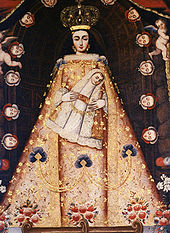 Anonymous Cuzco School painting, 18th century
Anonymous Cuzco School painting, 18th century
Peruvian culture is primarily rooted in Amerindian and Spanish traditions,[78] though it has also been influenced by various African, Asian, and European ethnic groups. Peruvian artistic traditions date back to the elaborate pottery, textiles, jewelry, and sculpture of Pre-Inca cultures. The Incas maintained these crafts and made architectural achievements including the construction of Machu Picchu. Baroque dominated colonial art, though modified by native traditions.[79] During this period, most art focused on religious subjects; the numerous churches of the era and the paintings of the Cuzco School are representative.[80] Arts stagnated after independence until the emergence of Indigenismo in the early 20th century.[81] Since the 1950s, Peruvian art has been eclectic and shaped by both foreign and local art currents.[82]
Peruvian literature is rooted in the oral traditions of pre-Columbian civilizations. Spaniards introduced writing in the 16th century; colonial literary expression included chronicles and religious literature. After independence, Costumbrism and Romanticism became the most common literary genres, as exemplified in the works of Ricardo Palma.[83] The early 20th century's Indigenismo movement was led by such writers as Ciro Alegría[84] and José María Arguedas.[85] César Vallejo wrote modernist and often politically engaged verse. Modern Peruvian literature is recognized thanks to authors such as Nobel laureate Mario Vargas Llosa, a leading member of the Latin American Boom.[86]
Peruvian cuisine blends Amerindian and Spanish food with strong influences from African, Arab, Italian, Chinese, and Japanese cooking.[87] Common dishes include anticuchos, ceviche, and pachamanca. Peru's varied climate allows the growth of diverse plants and animals good for cooking.[88] Peru's diversity of ingredients and cooking techniques is receiving worldwide acclaim.[89]
Peruvian music has Andean, Spanish, and African roots.[90] In pre-Hispanic times, musical expressions varied widely in each region; the quena and the tinya were two common instruments.[91] Spaniards introduced new instruments, such as the guitar and the harp, which led to the development of crossbred instruments like the charango.[92] African contributions to Peruvian music include its rhythms and the cajón, a percussion instrument.[93] Peruvian folk dances include marinera, tondero, zamacueca, and huayno.[94]
See also
- Outline of Peru
- Index of Peru-related articles
 Peru topics
Peru topicsHistory Timeline (Ancient cultures · Inca Empire · Spanish conquest · Viceroyalty · War of Independence · Guano Era · War of the Pacific · Colombia–Peru War · Ecuadorian–Peruvian war · Internal conflict) · Demographic · EconomicGeography Government Constitution · Electoral system · Foreign relations · Law · Law enforcement · Military · Nationality law · Regions and provincesPolitics Elections · Political parties (Alliance for the Future · APRA · National Unity · Possible Peru · Peruvian Nationalist Party · Popular Action · Union for Peru)Economy Culture Architecture · Art · Cinema · Cuisine · Demographics · Education · Languages · Literature · Media · Music · Public holidays · Religion · SportOther topics Index • PortalNotes
- ^ a b c d e "Peru". International Monetary Fund. http://www.imf.org/external/pubs/ft/weo/2011/01/weodata/weorept.aspx?sy=2008&ey=2011&scsm=1&ssd=1&sort=country&ds=.&br=1&c=293&s=NGDPD%2CNGDPDPC%2CPPPGDP%2CPPPPC%2CLP&grp=0&a=&pr.x=35&pr.y=6. Retrieved May 6, 2011.
- ^ "Gini Index". World Bank. http://data.worldbank.org/indicator/SI.POV.GINI/. Retrieved 2 March 2011.
- ^ "Human Development Report 2010". United Nations. 2010. http://hdr.undp.org/en/media/HDR_2010_EN_Table1.pdf. Retrieved November 5, 2010.
- ^ Quechua name used by government of Peru is Perú (see Quechua language version of Peru Parliament website and Quechua language version of Peru Constitution [1]), but common Quechua name is Piruw
- ^ Raúl Porras Barrenechea, El nombre del Perú, p. 83.
- ^ Raúl Porras Barrenechea, El nombre del Perú, p. 84.
- ^ Raúl Porras Barrenechea, El nombre del Perú, p. 86.
- ^ Raúl Porras Barrenechea, El nombre del Perú, p. 87.
- ^ Tom Dillehay et al, "The first settlers", p. 20.
- ^ Jonathan Haas et al, "Dating the Late Archaic occupation of the Norte Chico region in Peru", p. 1021.
- ^ Terence D'Altroy, The Incas, pp. 2–3.
- ^ Enrique Mayer, The articulated peasant, pp. 47–68.
- ^ Recopilación de leyes de los Reynos de las Indias, vol. II, pp. 12–13.
- ^ Peter Bakewell, Miners of the Red Mountain, p. 181.
- ^ Margarita Suárez, Desafíos transatlánticos, pp. 252–253.
- ^ Kenneth Andrien, Crisis and decline, pp. 200–202.
- ^ Mark Burkholder, From impotence to authority, pp. 83–87.
- ^ Scarlett O'Phelan, Rebellions and revolts in eighteenth century Peru and Upper Peru, p. 276.
- ^ Timothy Anna, The fall of the royal government in Peru, pp. 237–238.
- ^ Charles Walker, Smoldering ashes, pp. 124–125.
- ^ Paul Gootenberg, Between silver and guano, p. 12.
- ^ Paul Gootenberg, Imagining development, pp. 5–6.
- ^ Paul Gootenberg, Imagining development, p. 9.
- ^ Ulrich Mücke, Political culture in nineteenth-century Peru, pp. 193–194.
- ^ Peter Klarén, Peru, pp. 262–276.
- ^ David Palmer, Peru: the authoritarian tradition, p. 93.
- ^ George Philip, The rise and fall of the Peruvian military radicals, pp. 163–165.
- ^ Daniel Schydlowsky and Juan Julio Wicht, "Anatomy of an economic failure", pp. 106–107.
- ^ Peter Klarén, Peru, pp. 406–407.
- ^ BBC News, Fujimori: Decline and fall. Retrieved July 21, 2007.
- ^ The Economist, Peru. Retrieved July 18, 2007.
- ^ Constitución Política del Perú, Article N° 112.
- ^ Constitución Política del Perú, Article N° 122.
- ^ Constitución Política del Perú, Article N° 90.
- ^ Constitución Política del Perú, Articles N° 107–108.
- ^ Constitución Política del Perú, Articles N° 146.
- ^ Jeffrey Clark, Building on quicksand. Retrieved July 24, 2007.
- ^ Constitución Política del Perú, Article N° 31.
- ^ (Spanish) Oficina Nacional de Procesos Electorales, Elecciones Generales 2011 Segunda Elección Presidencial. Retrieved July 28, 2011.
- ^ (Spanish) Congreso de la República del Perú, Grupos Parlamentarios. Retrieved August 27, 2011.
- ^ Ronald Bruce St John, The foreign policy of Peru, pp. 223–224.
- ^ BBC News, Peru–Chile border row escalates. Retrieved May 16, 2007.
- ^ Ministerio de Defensa, Libro Blanco de la Defensa Nacional, p. 90.
- ^ Ley N° 27178, Ley del Servicio Militar, Articles N° 29, 42 and 45.
- ^ Ley N° 27867, Ley Orgánica de Gobiernos Regionales, Article N° 11.
- ^ Ley N° 27867, Ley Orgánica de Gobiernos Regionales, Article N° 10.
- ^ Ley N° 27867, Ley Orgánica de Gobiernos Regionales, Article N° 66.
- ^ AndesHandbook, Huascarán. Retrieved August 12, 2007.
- ^ Instituto de Estudios Histórico–Marítimos del Perú, El Perú y sus recursos: Atlas geográfico y económico, p. 16.
- ^ Instituto de Estudios Histórico–Marítimos del Perú, El Perú y sus recursos: Atlas geográfico y económico, p. 31.
- ^ Instituto Nacional de Estadística e Informática, Perú: Compendio Estadístico 2005, p. 21.
- ^ Instituto de Estudios Histórico–Marítimos del Perú, El Perú y sus recursos: Atlas geográfico y económico, pp. 24–25.
- ^ Instituto de Estudios Histórico–Marítimos del Perú, El Perú y sus recursos: Atlas geográfico y económico, pp. 25–26.
- ^ Instituto de Estudios Histórico–Marítimos del Perú, El Perú y sus recursos: Atlas geográfico y económico, pp. 26–27.
- ^ Instituto Nacional de Estadística e Informática, Perú: Compendio Estadístico 2005, p. 50.
- ^ United Nations Development Programme, Human Development Report 2010PDFRetrieved November 5, 2010.
- ^ Rosemary Thorp and Geoffrey Bertram, Peru 1890–1977, p. 4.
- ^ Rosemary Thorp and Geoffrey Bertram, Peru 1890–1977, p. 321.
- ^ Instituto Nacional de Estadística e Informática, Evolución de la Pobreza en el Perú al 2010, p. 38.
- ^ Rosemary Thorp and Geoffrey Bertram, Peru 1890–1977, pp. 318–319.
- ^ John Sheahan, Searching for a better society, p. 157.
- ^ (Spanish) Banco Central de Reserva, Producto bruto interno por sectores productivos 1951–2006. Retrieved December 27, 2010.
- ^ 2006 figures. (Spanish) Banco Central de Reserva, Memoria 2006, p. 204. Retrieved December 27, 2010.
- ^ (Spanish) Banco Central de Reserva, Memoria 2006, pp. 15, 203. Retrieved December 27, 2010.
- ^ Office of the U.S. Trade Representative, United States and Peru Sign Trade Promotion Agreement, April 12, 2006. Retrieved December 27, 2010.
- ^ 2006 figures. (Spanish) Banco Central de Reserva, Memoria 2006, pp. 60–61. Retrieved December 27, 2010.
- ^ Noble David Cook, Demographic collapse: Indian Peru, 1520–1620, p. 114.
- ^ Mario Vázquez, "Immigration and mestizaje in nineteenth-century Peru", pp. 79–81.
- ^ Magnus Mörner, Race mixture in the history of Latin America, p. 131.
- ^ United Nations, World Population ProspectsPDF (2.74 MB), pp. 44–48. Retrieved July 29, 2007.
- ^ Instituto Nacional de Estadística e Informática, Perú: Estimaciones y Proyecciones de Población, 1950–2050, pp. 37–38, 40.
- ^ Instituto Nacional de Estadística e Informática, Perfil sociodemográfico del Perú, p. 13.
- ^ Instituto Nacional de Estadística e Informática, Perfil sociodemográfico del Perú, p. 24.
- ^ Instituto Nacional de Estadística e Informática, Perfil sociodemográfico del Perú, p. 111.
- ^ Instituto Nacional de Estadística e Informática, Perfil sociodemográfico del Perú, p. 132.
- ^ Instituto Nacional de Estadística e Informática, Perfil sociodemográfico del Perú, p. 93.
- ^ Constitución Política del Perú, Article N° 17.
- ^ Víctor Andrés Belaunde, Peruanidad, p. 472.
- ^ Gauvin Alexander Bailey, Art of colonial Latin America, pp. 72–74.
- ^ Gauvin Alexander Bailey, Art of colonial Latin America, p. 263.
- ^ Edward Lucie-Smith, Latin American art of the 20th century, pp. 76–77, 145–146.
- ^ Damián Bayón, "Art, c. 1920–c. 1980", pp. 425–428.
- ^ Gerald Martin, "Literature, music and the visual arts, c. 1820–1870", pp. 37–39.
- ^ Gerald Martin, "Narrative since c. 1920", pp. 151–152.
- ^ Gerald Martin, "Narrative since c. 1920", pp. 178–179.
- ^ Gerald Martin, "Narrative since c. 1920", pp. 186–188.
- ^ Tony Custer, The Art of Peruvian Cuisine, pp. 17–22.
- ^ Tony Custer, The Art of Peruvian Cuisine, pp. 25–38.
- ^ Embassy of Peru in the United States, The Peruvian Gastronomy. Retrieved December 27, 2010.
- ^ Raúl Romero, "Andean Peru", p. 385–386.
- ^ Dale Olsen, Music of El Dorado, pp. 17–22.
- ^ Thomas Turino, "Charango", p. 340.
- ^ Raúl Romero, "La música tradicional y popular", pp. 263–265.
- ^ Raúl Romero, "La música tradicional y popular", pp. 243–245, 261–263.
References
- Etymology
- (Spanish) Porras Barrenechea, Raúl. El nombre del Perú. Lima: Talleres Gráficos P.L. Villanueva, 1968.
- History
- Andrien, Kenneth. Crisis and decline: the Viceroyalty of Peru in the seventeenth century. Albuquerque: University of New Mexico Press, 1985.
- Anna, Timothy. The fall of the royal government in Peru. Lincoln: University of Nebraska Press, 1979.
- Bakewell, Peter. Miners of the Red Mountain: Indian labor in Potosi 1545–1650. Albuquerque: University of New Mexico, 1984.
- BBC News. Fujimori: Decline and fall. November 20, 2000.
- Burkholder, Mark. From impotence to authority: the Spanish Crown and the American audiencias, 1687–1808. Columbia: University of Missouri Press, 1977.
- D'Altroy, Terence. The Incas. Malden: Blackwell, 2002.
- Dillehay, Tom, Duccio Bonavia and Peter Kaulicke. "The first settlers". In Helaine Silverman (ed.), Andean archaeology. Malden: Blackwell, 2004, pp. 16–34.
- Gootenberg, Paul. Between silver and guano: commercial policy and the state in postindependence Peru. Princeton: Princeton University Press, 1991.
- Gootenberg, Paul. Imagining development: economic ideas in Peru's "fictitious prosperity" of Guano, 1840–1880. Berkeley: University of California Press, 1993.
- Haas, Jonathan, Winifred Creamer and Alvaro Ruiz. "Dating the Late Archaic occupation of the Norte Chico region in Peru". Nature 432: 1020–1023 (December 23, 2004).
- Klarén, Peter. Peru: society and nationhood in the Andes. New York: Oxford University Press, 2000.
- Mayer, Enrique. The articulated peasant: household economies in the Andes. Boulder: Westview, 2002
- Mücke, Ulrich. Political culture in nineteenth-century Peru. Pittsburgh: University of Pittsburgh Press, 2004.
- O'Phelan, Scarlett. Rebellions and revolts in eighteenth century Peru and Upper Peru. Cologne: Böhlau, 1985.
- Palmer, David. Peru: the authoritarian tradition. New York: Praeger, 1980.
- Philip, George. The rise and fall of the Peruvian military radicals. London: University of London, 1978.
- (Spanish) Recopilación de leyes de los Reynos de las Indias. Madrid: Cultura Hispánica, 1973
- Schydlowsky, Daniel and Juan Julio Wicht. "Anatomy of an economic failure". In Cynthia McClintock and Abraham Lowenthal (ed.), The Peruvian experiment reconsidered. Princeton: Princeton University Press, 1983, pp. 94–143.
- (Spanish) Suárez, Margarita. Desafíos transatlánticos. Lima: FCE/IFEA/PUCP, 2001.
- The Economist. Peru. June 12, 2007.
- Walker, Charles. Smoldering ashes: Cuzco and the creation of Republican Peru, 1780–1840. Durham: Duke University Press, 1999.
- Government
- BBC News. Peru–Chile border row escalates. November 4, 2005.
- Clark, Jeffrey. Building on quicksand: the collapse of the World Bank's judicial reform project in Peru. New York: Lawyers Committee for Human Rights, 2000.
- (Spanish) Congreso de la República del Perú. Grupos Parlamentarios.
- (Spanish) Constitución Política del Perú. December 29, 1993.
- (Spanish) Ley N° 27178, Ley del Servicio Militar
 DOC. September 28, 1999.
DOC. September 28, 1999. - (Spanish) Ministerio de Defensa. Libro Blanco de la Defensa Nacional. Lima: Ministerio de Defensa, 2005
- (Spanish) Oficina Nacional de Procesos Electorales. Elecciones Generales 2011 Segunda Elección Presidencial.
- St John, Ronald Bruce. The foreign policy of Peru. Boulder: Lynne Rienner, 1992.
- Regions
- (Spanish) Ley N° 27867, Ley Orgánica de Gobiernos RegionalesPDF (305 KB). November 16, 2002.
- Geography
- AndesHandbook. Huascarán. June 2, 2002.
- (Spanish) Instituto de Estudios Histórico–Marítimos del Perú. El Perú y sus recursos: Atlas geográfico y económico. Lima: Auge, 1996.
- (Spanish) Instituto Nacional de Estadística e Informática. Perú: Compendio Estadístico 2005PDF (8.31 MB). Lima: INEI, 2005.
- Economy
- (Spanish) Banco Central de Reserva. Cuadros Anuales Históricos.
- (Spanish) Banco Central de Reserva. Memoria 2006. Lima: BCR, 2007
- (Spanish) Instituto Nacional de Estadística e Informática. Perú: Perfil de la pobreza por departamentos, 2004–2008. Lima: INEI, 2009.
- International Monetary Fund. Peru. January 2010.
- Office of the U.S. Trade Representative. United States and Peru Sign Trade Promotion Agreement. April 12, 2006.
- Sheahan, John. Searching for a better society: the Peruvian economy from 1950. University Park, Pennsylvania: The Pennsylvania State University Press, 1999.
- Thorp, Rosemary and Geoffrey Bertram. Peru 1890–1977: growth and policy in an open economy. New York: Columbia University Press, 1978.
- United Nations Development Programme, Human Development Report 2009PDF. New York: UNDP, 2009.
- Demographics
- Cook, Noble David. Demographic collapse: Indian Peru, 1520–1620. Cambridge: Cambridge University Press, 1981.
- (Spanish) Instituto Nacional de Estadística e Informática. Perú: Estimaciones y Proyecciones de Población, 1950–2050. Lima: INEI, 2001.
- (Spanish) Instituto Nacional de Estadística e Informática. Perfil sociodemográfico del Perú. Lima: INEI, 2008.
- Mörner, Magnus. Race mixture in the history of Latin America. Boston: Little, Brown and Co., 1967.
- United Nations. World Population Prospects: The 2006 Revision. HighlightsPDF (2.74 MB). New York: United Nations, 2007.
- Vázquez, Mario. "Immigration and mestizaje in nineteenth-century Peru". In: Magnus Mörner, Race and class in Latin America. New York: Columbia University Press, 1970, pp. 73–95.
- Culture
- Bailey, Gauvin Alexander. Art of colonial Latin America. London: Phaidon, 2005.
- Bayón, Damián. "Art, c. 1920–c. 1980". In: Leslie Bethell (ed.), A cultural history of Latin America. Cambridge: University of Cambridge, 1998, pp. 393–454.
- (Spanish) Belaunde, Víctor Andrés. Peruanidad. Lima: BCR, 1983.
- Concha, Jaime. "Poetry, c. 1920–1950". In: Leslie Bethell (ed.), A cultural history of Latin America. Cambridge: University of Cambridge, 1998, pp. 227–260.
- Custer, Tony. The Art of Peruvian Cuisine. Lima: Ediciones Ganesha, 2003.
- Embassy of Peru in the United States. The Peruvian Gastronomy.
- Lucie-Smith, Edward. Latin American art of the 20th century. London: Thames and Hudson, 1993.
- Martin, Gerald. "Literature, music and the visual arts, c. 1820–1870". In: Leslie Bethell (ed.), A cultural history of Latin America. Cambridge: University of Cambridge, 1998, pp. 3–45.
- Martin, Gerald. "Narrative since c. 1920". In: Leslie Bethell (ed.), A cultural history of Latin America. Cambridge: University of Cambridge, 1998, pp. 133–225.
- Olsen, Dale. Music of El Dorado: the ethnomusicology of ancient South American cultures. Gainesville: University Press of Florida, 2002.
- (Spanish) Romero, Raúl. "La música tradicional y popular". In: Patronato Popular y Porvenir, La música en el Perú. Lima: Industrial Gráfica, 1985, pp. 215–283.
- Romero, Raúl. "Andean Peru". In: John Schechter (ed.), Music in Latin American culture: regional tradition. New York: Schirmer Books, 1999, pp. 383–423.
- Turino, Thomas. "Charango". In: Stanley Sadie (ed.), The New Grove Dictionary of Musical Instruments. New York: MacMillan Press Limited, 1993, vol. I, p. 340.
External links
- Country Profile from BBC News
- Peru from the Encyclopædia Britannica
- Peru entry at The World Factbook
- Peru at UCB Libraries GovPubs
- Peru at the Open Directory Project
- PeruLinks web directory
- Wikimedia Atlas of Peru
- Peru travel guide from Wikitravel
- (Spanish) Web portal of the Peruvian Government
 OpenStreetMap has geographic data related to Peru
OpenStreetMap has geographic data related to Peru
Related information
Geographic locale Countries and dependencies of South America Sovereign states 
Dependencies NetherlandsUnited KingdomCategories:- Peru
- Andean Community of Nations
- Countries bordering the Pacific Ocean
- Former Spanish colonies
- G15 nations
- Liberal democracies
- Republics
- South American countries
- Spanish-speaking countries
- States and territories established in 1821
- Member states of the Union of South American Nations
- Member states of the United Nations
- Outline of Peru
Wikimedia Foundation. 2010.


